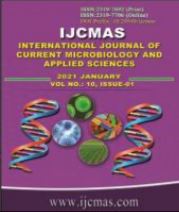


 National Academy of Agricultural Sciences (NAAS)
National Academy of Agricultural Sciences (NAAS)

|
PRINT ISSN : 2319-7692
Online ISSN : 2319-7706 Issues : 12 per year Publisher : Excellent Publishers Email : editorijcmas@gmail.com / submit@ijcmas.com Editor-in-chief: Dr.M.Prakash Index Copernicus ICV 2018: 95.39 NAAS RATING 2020: 5.38 |
Rice (Oryza sativa L.) and chickpea (Cicer arietinum L) is the most extensively cultivated cereal-pulses crops in India and other countries. In this experiment, for comparative performance of conservation machinery system in rice –chickpea cropping system various farm machines were used viz ridge and furrow planter sowing (T1), conventional seed cum fertilizer drill sowing (T2), zero till drill sowing (T3) and happy seeder sowing (T4). In T1 treatment fuel consumption was measured higher as compared to other treatments because there are used more tillage operation for better ridge and furrow formation. T3 and T4 were higher conservation of moisture content of the soil caused by incorporation of rice straw. Yiled attribute viz., Test weight was measured higher 28.28, seed yield was measured higher 18.25, harvest index 34.22 was measured higher in T1 (ridge and furrow sowing) treatment. The total energy input required in T1, T2, T3 and T4 treatments are 9221.5, 7842, 5448.5 and 5520 MJ ha-1, respectively. Minimum energy input requirement observed in T3 treatment because there is no tillage done followed by T4 (happy seeder sowing). In this experiment the total cost of cultivation (fixed and operating cost) required in T1, T2, T3 and T4 are 31261.36, 28107.07, 22734.25 and 23319.79 ₹/ha, respectively. In terms of total energy, total cost and total time requirement for chickpea production zero tillage and happy seeder sowing was found less than conventional and ridge and furrow sowing therefore, zero tillage and happy seeder has been recommended for early sowing with minimization of cultivation cost and reducing input energy consumption during rice- cropping system.
 |
 |
 |
 |
 |